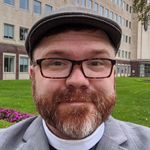We Will, With God's Help

Last week we spoke about senses of vocation in Christian life. We were encouraged by last week's readings from the Bible to be considering the many choices life puts before us in light of our commitments as Christians. Even in situations that might not appear, at first, to have much to do with our faith. Many years ago now, our ancestors in faith who lived in Hamilton saw a new neighbourhood being built here, along Locke and Dundurn streets. They knew that their siblings in faith would be living here and wanted them to have a proper place to gather as the people of God here, to worship, offer thanks and praise, and to be a sign of God's love and presence in this community.
From that desire and a great deal of prayer, charity, generosity, meetings in other buildings, and an enormous amount of hard work, a plot of land at the northwest corner of Locke Street and Charlton Avenue was eventually purchased. In due course, a building was erected with the intention that it would become the parish church. There have been a few adjustments over the generations. Those who laid the cornerstone in 1891 probably did not have visions of microphones and livestreams, to say nothing of women presiding at the altar. But for however much has changed, we share with them that vision of what the Church could be in this neighbourhood and that the means to make the vision real is through our one faith, one baptism, one Lord: Jesus Christ.
We humans set apart spaces for particular purposes. We learned long ago that it is helpful to separate the places where we eat from where we sleep from where we dance from where we do justice. We also set apart places for worship. Places where we meet God in special ways. The hymn We Love the Place, O God, written by Canadian the Revd William Bullock, first dean of St Luke's Cathedral, Halifax, gives over one verse to each of the important locations in a church building. The font, the altar, the lectern, and so on, speaking about how we meet God in different ways in each of these places. His descendants tell a family story about how he was once asked by a parishioner why he had not written a verse about the pulpit. He replied, saying "What would I write? We love thy pulpit, Lord, for there the word of man lulls the worshiper to sleep as only sermons can." Mr Bullock had a good sense of humility about just how much we can contribute and an awareness that the lion's share of the work is done by God for our sakes.
When we talk about church, most of us think of a building set apart for our business with God. It has become very popular in the last twenty years to say in these kinds of sermons that the Church is not a building! It is the people of God who gather in the building who are the Church! These are true statements. The people of God are the Church. But, church buildings are powerful statements to the world about the faith of the people who gather here. These buildings are a sign of commitment, of presence in the community. The building is an offering to God. None of us own it, though we all contribute to its maintenance and we all benefit from its presence. The church—that is, the people who gather here—are stewards of something that we have given to God and which God has filled with blessing and returned to us.
The cornerstone of this Church of St John the Evangelist says that it was laid in 1891, making the building about 133 years old. The Sentence of Consecration of the building, however, was promulged in 1956, 65 years after the structure began to go up. Why the long delay? Because the building, like all the rest of our work, is an offering to God and we cannot give to God what is not ours. The building could not be consecrated until the mortgage was paid and every part of this property was owned outright by the parish. It took a while to do, with a few interruptions. Setbacks like great wars and an economic depression may have extended the timeline on a few occasions. Whatever the circumstance, we cannot offer to God what we have not made our own.
Our offerings to God are never perfect, just as we are never perfect in this life. We can participate in God's creative acts, but we cannot accomplish the task fully without God's assistance. In preparing to celebrate the eucharist, we take wheat from God's creation, give thanks, make bread, and set it apart for worship. When we gather here, we offer that bread back to God who receives our imperfect offering and makes it perfect by contributing what we cannot. God consecrates our offering, makes it more than we can ask or imagine, and returns it to us, trusting that we will use it for our benefit, for our neighbour's benefit, and to show the whole world what it is to be a people who live in the blessing of God's love, even when we and our offerings are flawed. As George Herbert says in his poem Easter about our offerings to God, "O let thy blessed Spirit bear a part, and make up our defects with his sweet art." We offer the very best that we can manage, trusting that God's grace and mercy will be sufficient to cover our shortcomings."
Today's reading from the Gospel according to St John addresses this inadequacy and the anxiety it can create in our relationship with God. These short few verses are taken from the longer reading we hear on Pentecost. But, unlike the other evangelists, for John, this day is not about tongues of fire or an overwhelming rush of voices. When the disciples are gathered together in the place they have set apart for the purpose, they share their fear. Fear of the authorities who have killed their master. Fear of a world where Jesus is gone. Fear for their families and friends. Fear that they are not up to the task that Jesus entrusted to them before his death. Into this fear, Jesus steps and, without fire or beautiful cacophony, Jesus speaks peace. A single voice that pierces to the centre of troubled hearts and lays fear to rest.
When our ancestors in faith built this place, they set it apart as a place where God and God's people could meet in special ways. They named it as a place where community could gather and grow. They prayed for a place where the fearful could find shelter and hear words of peace, calming troubled hearts. We look to the tradition of the ancestors who built this place for inspiration for the future. Not as a museum or a people caught in one historic moment—a nostalgic "golden era"—but as people always discerning the movement of God's Spirit, responding to where we are called to be today, and praying for tomorrow.
We have a great task before us, as the people of God who meet in this place. We have promised again and again to continue the apostles' teaching and fellowship; to break bread, to pray; to resist evil and, when we fall into it, to repent and return to the Lord; to proclaim by word and example the good news of Jesus Christ; to seek and serve Christ in all persons; to love our neighbours as ourselves; to work for justice and peace and to uphold the dignity of every human being; to safeguard the integrity of all of God's creation and to respect, sustain, and renew the life of the Earth. That's a lot to do. It may even seem impossible.
I assure you that we cannot do it by ourselves, even with this fine building as a place to gather and be strengthened for the task. The good news is that we do not have to do it ourselves. Every brick plank, and pane of this building is a reminder that we are supported by the faith of our ancestors and that we approach the task led by a God who delights in being our help and our salvation. For this church—people and building—and for the many blessings they contain, thanks be to God.





